Mats? Stromberg
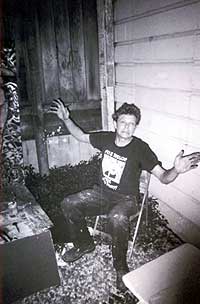
I first knew Mats? or Matso! Or Mats??! through his poster art and cartoons, especially through his contributions to The Weekly Weird News and Filth. Filth was an underground San Francisco newspaper I foolishly invested what should have been some of the best years of my life in. Bleeding and raw and reasonably psychotic at the end of that mad time-period I found that my former colleagues had gone on to bigger and better things (making money) and consistent sex lives while I was stuck telemarketing, exploring all the nuances of onanism and Greyhound bus trips to nowhere. Nevertheless I don't regret any of it. Least of all meeting mats?! My first impression was that he must have been a seriously pathological individual who did the sorts of drugs that were to be scrupulously avoided. When I actually got to know the man mats? Stromberg I found that the soft-spoken Swede could possibly be one of the nicest people you would ever meet. mats? quietly and with discipline continues to illustrate the nooks and crannies of subhuman deviance while mapping carcinogenic funny papers. His presence on the cultural landscape never rises too high (running the risk of oversaturation) and never sinks too low (that is disappears all together) while embracing with good humor what lesser souls can't even remotely acknowledge. This might be the secret of his success.
S: You were born in Sweden?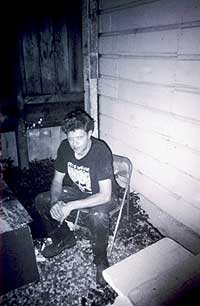
M: No I was born in France and I lived there for a while. I don't remember it much. I was a little kid when we lived there. My whole family moved around a lot. All my brothers were born in different countries. My dad was a briefcase type of guy, working in marketing and sales for a Danish company. He sold tooth-paste and that sort of thing. I wouldn't call him a traveling salesman. He got stationed in different countries to market hygiene products. I spent nine years in Switzerland actually, until I was thirteen.
Switzerland was childhood bliss you know [laughs]. I mean I didn't have anything to compare it to. At that age Sweden didn't seem any different than Switzerland to me besides the language I guess.
S: When did you come
to the United States?
M: Nineteen seventy-nine.
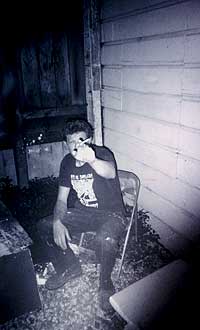
S: Why did you come
here?
M: Same thing. The whole family moved here. My dad got a job here. I was really excited: "We're moving to America!" I was just getting into skateboarding when I was thirteen in Switzerland and I envisioned California as having skate board parks all over the place. I'd seen the skate board magazines and that's what I figured. It would be wild and great. I also knew that every woman in America was beautiful. I'd seen the movies! Everyone was supposed to be a total doll and it was always sunny too. We ended up in Palo Alto.
S: I remember you
saying that when you arrived at SFO you saw this elaborate, huge, megaplex of
warehouses and airplane hangers and that everything was just really big. You
said that you had never seen anything on the scale of what it was in America.
M: Yeah it was bizarre coming in at night and then driving down the Peninsula. We stayed in a hotel for a few days before we moved into the house we were renting. I felt completely lost right away. There was nothing to focus on geographically because it was night. I just remember seeing all these big Chevron Gas Company signs and lights advertising all these businesses down US 101. It all looked like one place, like we had been driving in circles around the same town. If it all looked the same to me it at the same time looked completely foreign and alien. Little Swiss towns all kind of look the same too but you go twenty minutes in any direction and you are in the hills or the woods until you come to the next town but here the metropolitan areas all kind of melt together and kind of look the same: big corporate logos lit up at night.
S: Are your family
all back in Sweden now?
M: Yeah. They're all back there now except for one brother who is living here. They went back dejected. I went back too after spending three years here initially as a teen-ager. I guess I saw the American Dream as not being all it was made out to be. My mom wasn't happy here and I wasn't happy here so we all decided to go back to Europe. I finished high school here though.
††††††††††† I hadn't lived in Sweden except when I was a little kid and Sweden represented more of a summer destination to me because my family would go there in the summer and I hadn't actually lived there. I didn't really remember anything so getting back to Sweden after America I was alienated yet again [laughs]. I was like: "What am I doing here? Who am I?" Even though I spoke the language my family spoke home Swedish. I would crack jokes that I learned from my dad who was from another generation. Even though I could speak perfect Swedish without an accent I would say things and people would go: "Woah! Where did you come from? That's a forty-year old expression." I felt alienated there, not at home, so I decided to move back here on my own. I spent six months down in Palo Alto getting things ready with acquaintances before I made my big move up to San Francisco.
S: Did you go to art
school?
M: No, no, I didn't. I kind of wish I had. It seems like it would have been fun. Didn't have the money for it so it wasn't an option. I got into art and drawing probably because it was just something to do. A large part of it was moving around with my family and dealing with the alienation of having to adapt to different countries and learn new languages all the time was art-work. I've spent a lot of time alone. I've never been a very social person so illustration gave me something to put my hand to.
S: Was there anything
that inspired you?
M: The necessity to do it I guess. Almost like a nervous habit or something: a convulsion to do it. I enjoyed it. It was my little world where I could actually have some control over what goes on. If you feel sort of socially awkward you can create your own world you can inhabit. I've been drawing since I was six or seven years old.
S: What artists or
things that you would see inspired you?
M: I guess comics. I wasn't much of a reader when I was a kid except for comic books. I'm more of a book reader now then back then. There were always comics around. My mom used to read us comics in bed. I have three brothers and we would all sit around while mom read to us. We'd look at the images and hear her reading them.
S: A lot of your comics seem to fixate on the grotesque: weird diseases and weird sex. Somebody looking at your artwork for the first time, not knowing you, might go: "Man this guy is an off-the-hook pervert." You're actually a very soft-spoken mellow guy. What's the interest in this subject-matter? How did it evolve?
M: I don't know. I guess I just enjoy the subject matter. I enjoy the aesthetic. You look around at commercial art, normal commercial fare you get bombarded by these billboards pretending to show you something that's good or beautiful. They never focus on the ugly background. There's plenty of beauty in the ugly things out there, the so-called ugly; there's beauty in things that are horrifying you know? Beyond disgust it's more fun to draw.
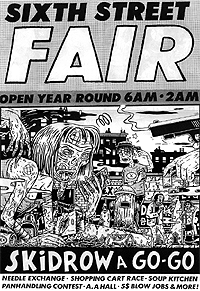
S: I remember one of
the first things I saw of yours was the Sixth Street Fair poster. In San
Francisco there's all these street fairs which are commercial orgies basically:
The Haight Street Fair, The Folsom Street Fair, The Fillmore Street Fair. Some
are more extreme than others obviously. The Folsom Street Fair has gay leather
daddies with no pants on while the Fillmore has a lot of yuppies.
M: Jazz and white wine.
S: Exactly.
M: Yeah they all have some kind of connection to a social-economic culture. I guess it pertains to the neighborhood and its character. Folsom Street has the gay leather scene while the Sixth Street Fair is an imaginary fair that reflects the character of Sixth Street, the attitudes of the area.
S: The yellow tape
aesthetic.
M: Yeah exactly. The inspiration for me doing that poster was they were talking about canceling the Haight Street Fair that year for some reason. I forgot what year this was but sometime during the early nineties. The city was objecting to public drinking and people urinating in public. I wasn't planning on putting on a street fair. I thought I'd fake a street fair that would replace the Haight Street Fair if it was canceled: The Sixth Street Fair -- one that would be the extreme epicenter of all that's wrong in the city. This would be something that people would cringe at like an embodiment of hell. American art and advertising is always showing you the pictures of prosperity and nice houses with cars but in reality every big city or small American city has poverty and all kinds of horrible shit you know? You don't really see that in advertising so I thought I'd bring attention to everything advertising liked to forget about.
S: Well your poster
is so over the top that it's hard not to notice. You have this prostitute
crawling on all fours and she's got a syringe in her arm and abscesses and
she's got a condom on her tongue. In the back-ground there's murder, suicide,
wretchedness. It's great punk rock social criticism rendered in a very
cartoon-like fashion. It's a real criticism of the images of perfection that
are constantly being created.
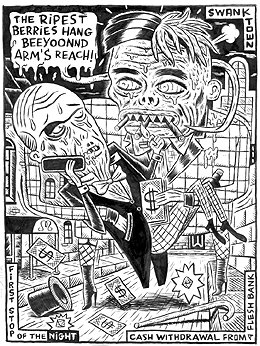
M: Yeah I was trying to attack all of that. Any art is a symbol. You're not going to see a prostitute standing around with a condom on her tongue -- well maybe you could -- but I just tried to take all these elements and just try to compress them into one powerful image. It's not reality.
S: You used to wheat
paste these posters around town right?
M: Yeah I would put them around town either with wheat paste or I would staple and tape. Sometimes friends would help me.
S: What kind of
responses did you get?
M: I usually got good responses. Usually someone would want
a poster when I put them up. At first the idea was to make them seem legit.
That was the case with the Sixth Street Fair. I actually wanted to fool people
into thinking it was real. I went as far as putting a date on it. I mean no one
would really think it was real but I
did my best. I had so much fun drawing it that I kind of got away from the
original concept. I don't think I fooled anyone. I actually went down to Sixth
Street on the scheduled day to see if anyone would show up -- of course not.
††††††††† People
wanted the posters though. They didn't last long on the light posts.
S: You also put out
a† newsprint tabloid which featured your
art -- San Fransicko.
M: Yeah. I always had trouble getting published by people for some reason. I'm just not forceful at getting my work out there. I think I'm not very ambitious in that way. If somebody rejects my stuff I just say "Okay." So in order to get it out there I would do it myself. Most of the comic books that I've done have been published by myself except for work which has appeared in anthologies. It's just like an exercise; I'll put it out myself. It's always important to get your stuff out one way or another.
S: How did you get
the money together to do this?
M: I borrowed money from a friend -- this older friend, a responsible person with a little bit extra disposable income. He's helped me out many times -- I've paid him back every time. I always broke even with my projects. It's very hard to get the cash to put something out. It's kind of expensive.
S: How much did it
cost you to print up your work back in the early nineties?
M: It cost me $400 or something. I'd go to a printer to print out a thousand papers but then the printer would talk me into doing 2000 more and say "Well once you've got a thousand the press is rolling: it would only cost you $200 more for an extra 2000." So I would think: Wow! Hey that's going to bring my cost per issue way down [laughs]. Instead of costing me a dollar per issue it will only cost me .40 per issue. Which means I've got a thousand sitting in my basement unsold of course.
S: How many issues or
editions did you do?
M: It was only one issue. I've done other publishing but I've never published anything with the same name twice. I don't think I have anyway. Every time I've published something else I've decided to call it something else. It's not a very smart way to go about things commercially because people want to see repeat characters that they can identify with or follow like a TV show. I've never done that. I get bored with something once I'm done with it and don't want to go back there.
S: I remember you
were trying to create a repeat character: Clark Olafson.
M: My alter-ego yeah. He's named after Sweden's most notorious criminal ever. His name is so perfect because it's culturally schizophrenic. Clark is an English or American name and Olafson is a typical Swedish name. So I thought that's me man! I'm living in America as a culturally schizophrenic Swede. Plus it fit well in the comic world with Clark Kent being Superman's secret identity.
S: If I remember your
comic strip Clark had a lot of misadventures with food stamps and impoverished
living.
M: Yeah he's a total bummer all the time [laughs]. Again an anti-hero. I can't help myself. I don't know.
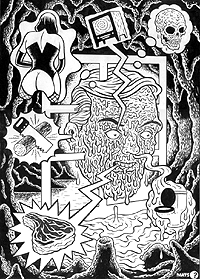
S: What was the real
Clark Olafson's crime or racket? What did he do?
M: He was a complete career criminal in Sweden. He was always in trouble with the law. This was in the late sixties and throughout the seventies. I remember going to Sweden as a kid in the summer and people would be reading the tabloids or I would see the taxi sheets advertising the tabloids and the headlines would proclaim "CLARK ON THE RUN" or "CLARK ESCAPES AGAIN" -- that kind of thing. There was a big famous bank robbery in Stockholm in 1972 I think where they took hostages. It was a completely failed bank robbery but it is what gave rise to the term "Stockholm Syndrome." They may have changed it to the "Patty Hearst Syndrome." This is where the captives identify with their captors.
S: Okay.
M: Most of the people in the bank ended up sympathizing with their captors. One of the hostages was one of my family's former nannies. When we were living abroad my parents would get these Swedish girls to come over to help us learn the language of whatever country we were living in and help take care of us. After taking care of us for six months one of these girls became one of the hostages so that's another connection with Clark Olafson.
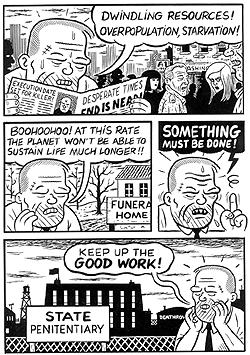
S: So Clark Olafson
was the leader or a leader of this gang of bank robbers in Stockholm?
M: Well he didn't commit the initial bank robbery but he was called in by the bank robbers. They demanded Clark Olafson be present for some reason and he went in there. They took him from some prison and brought him to the bank. I'm not an expert on this whole case.
S: It all sounds like
Dog Day Afternoon.
M: He's still in the news and a very distinguished public figure. He's Sweden's most famous criminal. He spent eight years in jail but he never killed anybody. For a while he tried to go straight but he got busted a few years ago for being the leader of some kind of heroin smuggling ring. He's always involved in some sort of scam. He became a journalist for a while. A sensationalistic Geraldo Rivera kind of journalist.
S: On TV?
M: No print journalism. Clark doesn't have the Swedish mentality at all which is probably why he is so fascinating to a lot of Swedes. "An outlaw? We don't have any outlaws!"
S: Sweden has about
ten crimes a year or something like that.
M: We had a brutal homicide two days ago.
S: I heard that. Some
high-ranking cabinet minister?
M: The Foreign Minister, which is the equivalent of the
Secretary of State. She got stabbed in a super market. I got a couple of
e-mails from Sweden. She was really outspoken against America's politics and
Israel's politics but they don't know if it's any kind of political
assassination. It seems like it was to me. Someone dressed in military fatigues
was the perpetrator, that's how they describe the assailant, he disappeared and
ditched the knife. She was attacked in the Swedish equivalent of Macy's. She
died yesterday from massive internal wounds.
††††††††††† Sweden is
not like here where the politicians ride around in dark limousines and you
never see them. I was living in Sweden when Olaf Palme, the Prime Minister, got
shot. I'd see him around town riding the bus. He got shot coming out of a movie
theater.
S: When did that
happen?
M: In 1986. They never found the killer.
S: Are people bored
or what?
M: Well I think it was a political killing. I've read since they think the South African secret police had something to do with it because Palme was outspoken about being anti-apartheid. I think this latest killing is political too only they don't know who is behind it. My brother said he had seen her three days ago. She lived in his neighborhood. She lived in a little apartment and took the bus to parliament every day. They don't have security guards. I guess the Prime Minister and the King do but no one else does.
S: An open and
easy-going society.
M: Yeah they try to be egalitarian and not have a huge division between the power and the people. They try to do the social ideal. I have a lot of respect for Swedish politics in a lot of ways -- I just wasn't happy living there. It's kind of silly since it seems so ideal. I'll talk to my friends there and everybody has six weeks paid vacation.
S: Maybe you found it
boring. There weren't† enough problems.
M: Yeah, I guess. I don't know what it is. Here in the
United States it's trouble all the time [laughs]. Yeah it keeps you on your
toes. They put you to sleep there because you don't have to worry about much.
You would think that would give you time to pursue creative venues but it did
the opposite to me. Everything was so even-keeled and, yeah, I guess boring
would be a good way to put it.
††††††††††† People do
have fun. They go out to clubs and rock shows, same as here. When you compare
the two places there's no reason why it should be boring. I think it's a
personality thing. I wasn't happy there at all. I'm not happy here either but
there's so much fucked up shit it does inspire me I guess.
S: Now with the Clark
Olafson comic strip you were running that in SF Frontlines?
M: Well the idea with that was I was actually trying to be
responsible andÖ I was in my thirties and I decided I needed to try and make
some money off of what I liked to do. It was a conscious attempt to seduce the
mainstream. It was meant to be a daily newspaper strip in The Chronicle. I did a month's worth of strips and I pitched it to
all the syndicates. Of course all of them rejected it. I collected rejection
letters.
††††††††††† There was a
lot of social commentary in Clark Olafson
but I guess people don't want to read bummer things in the cartoons. It's
funny because the paper is full of fucked up stuff. Look at the front page!
Comic strips are supposed to be a diversion from all of the daily atrocities I
guess. They provide a few seconds of humor. Ninety percent of the comics page
just stinks though and isn't funny at all.
S: Well the most edgy
thing in the comic strips is probably Doonesbury
and that's not that edgy.
M: Boondocks.
S: Boondocks yeah, but most of the
representations of life in the comic strips are middle-class, white middle-brow
mow your lawn jokes. The strips are very middle-American consensus.
M: Cathy always had to worry about her weight and that was the greatest problem she had.
S: That one died.
M: It's gone now?
S: Yeah it died about
eight years ago. Everybody hated it. I don't know anybody that liked Cathy. I know more people that hated Cathy than hated The Family Circus.
M: I kind of liked the portrait in The Family Circus.
S: "Not
Me."
M: For a while I was reading the cartoons anyway, out of habit, everyday. I'd skip over some but I can't even read them now -- any of them. They don't do it for me.
S: There's nothing
progressive, or edgy, intellectual or dynamic or redeemingly weird about any of
them. They're not even funny.
††††††††††† I did see Clark Olafson around.
M: Yeah well maybe Frontlines †ran one or two and Filth ran one or two before the demise of Filth. Then I ran some in Buzzard and I forget where else. They should be out now in Legal Action Comics. I've got the whole run. I've revived the character now and again.
S: It might be a
self-published comic you did but Clark Olafson kills Dilbert at one point.
First he sodomizes him then he kills him and chops him up and eats him.
M: Yeah that was my revenge on the syndicates for not publishing me. The whole comic is a revenge comic. This is my alter ego taking revenge on my nemesis, killing him. At the time, at least locally, Dilbert was the most popular syndicated daily. He symbolizes something -- the office culture.
S: Cubicles and
Starbucks.
M: Which I don't understand at all. I can't say I hate that office culture. I was ambivalent. It was just another comic strip in the paper. I guess I did hate it at the time. Revenge comics are always fun. Or revenge stories in general.
S: That's the whole
appeal of Batman. They killed his
daddy. But you did manage to get gigs with your artwork?
M: Not anymore because I don't even try anymore. I was living off commercial work for a while. I thought I might as well make a living doing something I enjoy rather than going to work. I might as well work at home. I ended up not enjoying it so I don't pursue it anymore. I have the occasional gig sometimes but I don't pursue art as a career. I still have gallery shows. I'm just not doing it commercially. I've got a job that pays the bills, pays the rent. I try to keep the creative process separate from having to make a living. One thing takes care of another thing. I do need some security. I don't want to be on the complete edge. I need some stability which is maybe middle-age kicking in. I don't want to live in constant fear of being evicted. I don't want to live on the street because the street is hell. I wouldn't be able to get any artwork done at all that way. Maybe I should just quit my job and go for it but Iím not very ambitious in that way.
S: It would take a
lot of discipline to live like that. To really be productive it takes a lot of
discipline.
M: I go through phases. To me there's a compulsion or obsession. I go through these periods of creative menstrual cycle or something.
S: You're just
sitting around and there's no inspiration?
M: Yeah! I'm just dumb. I can't do anything. I'll never draw or paint again! There are these totally depressive states that I have. When I'm there I have to go back to the basics.
Other than that I work pretty consistently. I don't have anything else to do. I'll just do art. I don't have much of a social life you know. I don't hang out with the crowd or do things so I don't have anything better to do than do my art. I could watch TV but I don't really like TV. I don't have anything else to do so I'll do my art. Why not?
S: Even though you're
not that ambitious do you have any plans for your visionary art complex?
M: Yeah the latest obsession was inspired by a trip I took
to South East Asia about six months ago. I'm doing a travelogue and doing a
little more writing because writing has always been my Achilles' heal since I
think visually. I'm doing a travelogue account of my trip to Thailand, Cambodia
and Laos. I'm chronicling both the bizarre and mundane things I came across out
there. That's also branching out into sculpture and this sculpture project that
I want to do based on what I saw on my travels.
††††††††††† I went to a
sculpture park that depicted Buddhist hell. This park had these amazing,
hoffifying visions of hell done out of these sculptures that were painted in
bright colors. All kinds of horrible shit happening. It was like Disneyland! I
want to do an installation like this one, like Buddhist hell!
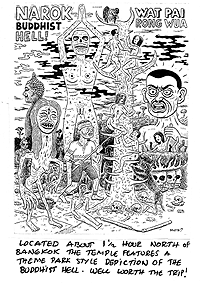
S: The Buddhist hell
was in Cambodia?
M: The Buddhist hell was in Thailand.
S: What did you see
there? What kinds of sculptures?
M: Well I'm not versed in Buddhism.
S: Just tell me what
you saw.
M: Oh god! There was one thing that had to be at least sixty feet tall. This one thing was a thorned tree with these naked people climbing up it -- male and female -- being pierced by these thorns and they're being chased up this tree by these -- I guess guardians of hell -- with spears and attack dogs down at the bottom forcing them to climb up. At the top there were buzzards waiting for these people so they would have to climb back down before they got to the top. So there was this constant cycle of climbing up and down. It's hell for adultery or something like that and it's visually insane. Like I said, I'm not versed in Buddhism, but the only Buddhism I ever saw was the beatific, contented smile of the Buddha -- which is cool, I like that, but I didn't know they had a hell -- and it's a really colorful hell.
S: I don't know that
much about Buddhism either but I guess, from reading The Tibetan Book of the Dead, that there are a number of different
hells.
M: Yeah there's a bunch of them. I know that. Apparently hell isn't forever though.
S: Hell lasts until
you burn up your bad karma.
M: It lasts a fucking long time but it's not forever. Just until you can reincarnate or go to Nirvana. There are different hells for people who abuse animals and things like that. There's this one sculpture I'm working on now -- I started with simpler building materials and subjects -- this one is a humanoid body with a chicken head that has a cleaver smacked into it's head. That's a kind of hell for people who kill animals. I should show you the pictures.
S: What kind of
materials are you using?
M: I'm using your very basic hardware/Home Depot style. Commercially available materials I can buy cheap. I started out with wood and built a basic skeleton. On top of that skeleton I used chicken wire. Then over that burlap dipped in Fix-All which is really basic to use. It's a lighter weight version of what I saw them using in Thailand. They were using rebar, chickenwire, bricks and then finished everything in cement. I saw different things in different temples that I got inspired by. I might do some cement pieces that will weigh a lot. I might have gallery shows with this theme using objects that are more light weight so I can move them around easily because I don't have a temple. Maybe I can do Buddhist Hell Park in my backyard and charge admission.
S: What is a
recurring obsession in your artwork or is there one?
M: I donít think there's a recurring obsession. I kind of try
to makeÖ I don't want to shock people but I do want to grab their attention --
make them stop and look at my work. I want to do striking things. I do take
that approach. I think about the audience and their response more than the
subject-matter sometimes. The subject-matter comes out afterwards. I start out
somewhere and what I'm doing can mutate into something else or something more
developed. But I do work with the audience in mind. I think about what people
will see. I will change the subject-matter if I get bored. I'll take forays
into different avenues. Right now, besides the sculptures, I did weird little
stream-of-consciousness paintings or "Jazz paintings" I call them
[laughs]. If I showed them to people they'd never think it was me that did
them: colorful and abstract and there's nothing there. It always changes.
††††††††††† I don't
know what I'm doing sometimes. I don't have a conscious theory of the work that
I'm doing. I have to look at it all myself and analyze it or something but I
don't. I should. What's the pattern here? The easy way to do it is to say that
people find my artwork disgusting. "Eww that's gross!" I don't think
it's that one-dimensional though.